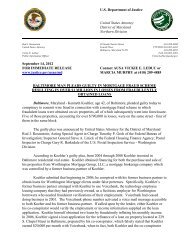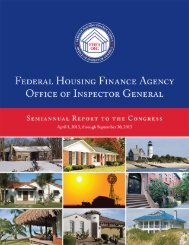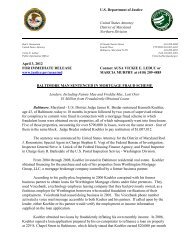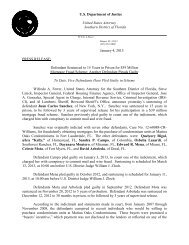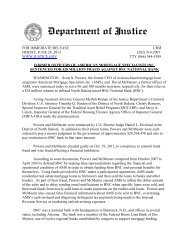FEDERAL
SemIannual report - Federal Housing Financing Agency - OIG
SemIannual report - Federal Housing Financing Agency - OIG
- No tags were found...
You also want an ePaper? Increase the reach of your titles
YUMPU automatically turns print PDFs into web optimized ePapers that Google loves.
Inaugural Semiannual Report to the Congress | March 31, 2011<br />
purchasing conventional conforming mortgages from thrifts and issuing MBS<br />
rather than holding these mortgages in its portfolio. In doing so, Freddie<br />
Mac transferred the interest rate risks associated with the mortgages that it<br />
purchased to investors in its MBS. By contrast, Fannie Mae followed its<br />
traditional business strategy of purchasing mortgage loans and holding them<br />
in its portfolio, which increased its interest rate risk. 59<br />
The inflation and recessions of the late 1970s and early 1980s and the sharp<br />
rises in interest rates that accompanied them put tremendous financial strain<br />
on Fannie Mae and many thrifts, which funded their mortgage holdings<br />
principally with short term obligations such as deposits. By contrast, Freddie<br />
Mac’s financial performance was relatively unaffected because of its emphasis<br />
on issuing MBS. 60<br />
During this period, the federal government provided financial benefits to<br />
Fannie Mae, such as regulatory forbearance and tax benefits, to help Fannie<br />
Mae recover from its financial losses. 61 Additionally, the Garn-St. Germain<br />
Depository Institutions Act of 1982 permitted thrifts to diversify their<br />
investments into potentially more profitable, but riskier, investment and loan<br />
activities. Due to the associated risks, many thrifts experienced substantial<br />
losses because of risky loans and investments, a condition that was aggravated<br />
by the recession of the early 1980s. 62<br />
Freddie Mac Reorganized<br />
The savings and loan crisis of the 1980s resulted in billions of dollars of<br />
losses throughout the housing market. By 1989, the Federal Savings and<br />
Loan Insurance Corporation (“FSLIC”), which provided deposit insurance<br />
for thrift customers, was insolvent. In response, Congress enacted the<br />
Financial Institutions Reform, Recovery, and Enforcement Act (“FIRREA”)<br />
in 1989. Among its provisions, FIRREA abolished the FSLIC, transferred<br />
its assets, liabilities, and operations to the newly created FSLIC Resolution<br />
Fund, and created a new insurance fund for thrift depositors known as the<br />
Savings Association Insurance Fund. FIRREA also created the Resolution<br />
Trust Corporation to resolve all troubled financial institutions placed into<br />
conservatorship or receivership. 63 Ultimately, the savings and loan crisis cost<br />
taxpayers about $125 billion and the thrift industry $29 billion. 64<br />
Federal Savings and Loan Insurance<br />
Corporation (“FSLIC”):<br />
Created by the National Housing Act of<br />
1934, the FSLIC, which was administered<br />
by the FHLBank Board, insured savings and<br />
loan deposits until 1989.<br />
FIRREA also reorganized Freddie Mac’s corporate structure to one similar to<br />
Fannie Mae’s: a for-profit corporation owned by private shareholders rather<br />
than by the FHLBanks.<br />
FIRREA also restructured the regulatory framework for FHLBanks by<br />
abolishing the FHLBank Board. FIRREA assigned oversight responsibilities<br />
of the FHLBanks to the newly created Federal Housing Finance Board and<br />
opened membership in the FHLBank System to depository institutions<br />
(including eligible commercial banks and credit unions) that had more than<br />
10% of their loan portfolios in residential mortgage-related assets. 65 As a<br />
A Brief History of the Housing Government-Sponsored Enterprises | 51



